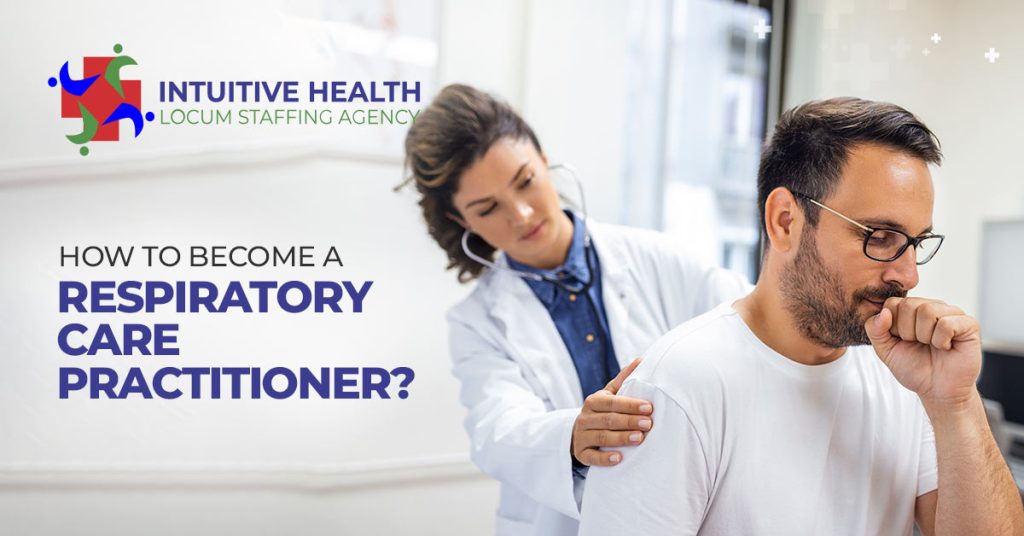Every day, people face serious breathing challenges. Respiratory conditions like asthma, COPD, and sleep apnea affect many patients. The need for skilled professionals who can treat these problems is rising quickly.

According to the Bureau of Labor Statistics, respiratory care jobs are growing faster than most careers. The American Association for Respiratory Care (AARC) also highlights a strong demand for trained practitioners. This makes respiratory care a stable and rewarding career choice.
In this blog, you will learn step by step how to become a Respiratory Care Practitioner (RCP). From education to licensure, this roadmap will show you how to enter a career that changes lives every day.
Step 1: Understand the Role of an RCP
A Respiratory Care Practitioner (RCP) or pulmonologist helps patients with breathing problems. They test, treat, and support people with lung conditions. These include asthma, COPD, pneumonia, and sleep apnea. Their work combines clinical care, technology, and patient education.
The role of an RCP is often confused with other titles. A Respiratory Therapist (RT) is the broader term used widely. An RCP is the licensed title used in many states. A Certified Respiratory Therapist (CRT) is someone who has passed the entry exam. A Registered Respiratory Therapist (RRT) holds advanced certification after higher-level exams. In practice, most RCPs hold the RRT credential.
RCPs work in many places, such as in hospitals, emergency rooms, and intensive care units. They also work in outpatient clinics, home health, and sleep disorder labs. They care for patients of all ages, from newborns to seniors.
Understanding the RCP role is the first step. It shows how important they are in helping people breathe better every day.
Step 2: Meet the Basic Education Requirements
To begin a career as a Respiratory Care Practitioner, students need a high school diploma or GED. This is the foundation for all further training.
Specific subjects prepare students better for this path. Classes in biology, chemistry, and anatomy provide a solid foundation in the human body. Math and health science also build functional problem-solving skills.
A solid science foundation is essential for success in respiratory care. RCPs deal with complex body systems and medical devices daily. With strong basics, students can understand advanced topics more easily in college programs.
Starting early with the right subjects makes the journey smoother. It gives students the confidence to progress into accredited respiratory therapy programs. This step ensures they are ready for both classroom learning and clinical practice.
Step 3: Enroll in an Accredited Program
After high school, the next step is enrolling in an accredited program. A CoARC-accredited program is required to become a Respiratory Care Practitioner. This ensures the program meets national standards for training.
Students can choose between an Associate’s degree and a Bachelor’s degree in Respiratory Therapy. An Associate’s degree usually takes about two years. A Bachelor’s degree may take four years, but offers broader opportunities.
Choosing the right program depends on goals and resources. Students should consider location, cost, and career support services. Programs with strong ties to hospitals provide better clinical training.
Clinical training is a key part of every program. Students practice in hospitals, clinics, or labs under supervision. They learn to handle ventilators, run tests, and support patients. This hands-on training builds confidence and prepares students for real-world practice.
Completing an accredited program is a significant milestone. It opens the door to certification and future licensure.
Step 4: Earn National Certification
After completing an accredited program, students must earn certification. The National Board for Respiratory Care (NBRC) provides two main exams. These are required to practice as a Respiratory Care Practitioner.
The first exam leads to the Certified Respiratory Therapist (CRT) credential. This is the entry-level certification for new graduates.
The next step is the Registered Respiratory Therapist (RRT) credential. This is an advanced certification that requires passing a more challenging exam.
Difference between CRT and RRT
A CRT is the starting point for practice. It shows basic skills and knowledge. An RRT shows higher expertise and readiness for complex cases. Many states now prefer or require the RRT.
How Certification Improves Career Opportunities
Certification builds trust with employers and patients. It opens doors to better-paying jobs and leadership roles. Advanced credentials also create paths into specializations like neonatal care or sleep medicine.
Passing these exams is a key step forward. It proves competence and prepares students for state licensure. The recent research study showed that many respiratory therapists in New York believe the profession risks losing practitioners without expanded clinical roles and growth opportunities. The study also found strong support for raising the minimum academic standard to a bachelor’s degree and for greater professional autonomy to ensure long-term viability.
Step 5: Apply for State Licensure
Certification alone is not enough to practice. Most states in the U.S. require a license for Respiratory Care Practitioners. Licensure ensures that only qualified and trained professionals provide care. It also protects patients and sets clear practice standards.
Why Licensure Is Required in Most States?
Licensure proves that an RCP has met education and exam requirements. It confirms that the practitioner can safely treat patients. Without a license, one cannot legally work in many states.
State-by-State Variation
Each state has its own rules. Some require the CRT credential, while most prefer or mandate the RRT. Application fees, background checks, and paperwork also differ by state.
Renewal Rules and Continuing Education
As per law, licenses must be renewed every 1 to 3 years. Therefore, RCPs complete their ongoing education credits in order to stay updated. This continued training assures safe, modern, and effective patient care.
Securing licensure is an essential step toward practicing legally and building trust with patients and employers.
Read More: What Does a Clinical Psychologist Do?
Step 6: Gain Clinical Experience
Knowledge is built from classroom learning and training, but real skill comes from practice. Therefore, clinical experience as a pulmonologist is highly important as it allows them to implement what they have learned and gain confidence.
Internships and clinical rotations place students in real healthcare settings. They work alongside licensed RCPs and medical teams. These roles prepare them for the fast pace of hospitals and clinics.
During training, students gain experience in ICUs, ERs, and outpatient clinics. In ICUs, they learn ventilator management and critical care. In ERs, they respond to breathing emergencies under supervision. Outpatient clinics provide long-term care exposure for chronic lung conditions.
Mentorship and supervised practice matter at this point. Experienced RCPs guide students, correct mistakes, and share practical tips. This support builds both technical and emotional readiness.
Hands-on practice bridges the gap between theory and real-world care, and makes students feel confident and job-ready professionals.
Step 7: Develop Essential Skills
Respiratory Care Practitioners or pulmonologists need strong skills to succeed. These include technical ability, patient communication, and personal qualities.
- Technical Skills
- Operate and adjust ventilators in critical care units.
- Perform Pulmonary Function Tests (PFTs) to assess lung health.
- Deliver safe oxygen therapy and monitor patient response.
- Communication and Education
- Explain treatments in clear, simple language to patients.
- Teach families how to use home breathing equipment.
- Guide lifestyle changes that improve lung health.
- Empathy, Resilience, and Teamwork
- Show compassion to patients facing fear and discomfort.
- Stay calm and focused during stressful emergencies.
- Work closely with doctors, nurses, and healthcare teams.
These skills make RCPs effective in both technical and emotional care. If you master these skills, you can do safe treatments and bring better patient outcomes.
Also Read: What is the role of Rehabilitation therapist?
Step 8: Explore Specializations and Career Growth
Respiratory care offers many paths for growth. After gaining experience, RCPs can move into specialized areas.
Some focus on neonatal or pediatric care, helping newborns and children with breathing problems. Others work in pulmonary rehab, guiding patients with chronic lung disease. Sleep medicine is another option, where RCPs treat sleep apnea.
For those seeking advanced roles, the Advanced Practice Respiratory Therapist (APRT) is a growing field. APRTs assume greater decision-making responsibilities, similar to nurse practitioners.
Beyond clinical work, RCPs can pursue leadership, education, or management. They may lead hospital departments, train new students, or manage respiratory teams.
Exploring these paths gives RCPs room to grow. It also ensures patients get expert care across different stages of life.
Step 9: Understand Challenges and Realities
Becoming a Respiratory Care Practitioner brings rewards, but also challenges. Students and professionals must be ready for the demands of this career.
RCPs often work shift schedules, including nights, weekends, and holidays. The job can be hectic or stressful, especially in emergency or ICU settings. The emotional toll of caring for critical patients is also real.
There are financial costs to consider. Education programs, certification exams, and state licenses all require investment. Continuing education for license renewal also adds to expenses.
RCPs also carry ethical and legal responsibilities. They must follow strict safety rules and protect patient privacy, as decisions made during care can affect patient lives.
Understanding these realities helps prepare future RCPs. They can manage such challenges and find long-term success with awareness and support.
Suggested Reads: How to Become a School Psychologist?
Step 10: Plan Your Career Path Forward
Becoming a Respiratory Care Practitioner is a step-by-step journey. Success depends on planning and staying focused on long-term goals. With the proper roadmap, students can move smoothly from education to practice.
Create a Roadmap: Education → Exams → Licensure → Job
The first step is completing an accredited program. Next comes passing the CRT and RRT exams. After that, applying for state licensure makes practice legal. Once licensed, candidates can begin working in hospitals, clinics, or home health.
Tips for Building a Successful Career in Pulmonology or Respiratory Care
- Set clear goals early. Decide on specialization interests.
- Stay updated. Take continuing education seriously.
- Find mentors. Learn from experienced RCPs in the field.
- Gain variety. Work in different settings to build skills.
- Balance stress. Practice self-care to handle emotional demands.
- Network actively. Join professional groups like AARC.
- Plan growth. Consider advanced practice, leadership, or teaching roles.
A strong plan can help RCPs or pulmonologists build steady and fulfilling careers. Each step opens doors to new skills, opportunities, and ways to impact patient lives.
Conclusion: Your Journey to Becoming a Respiratory Care Practitioner or Pulmonologist
The path to becoming a Respiratory Care Practitioner is clear. All you need is quality education, certification, and proper clinical training. Combining all these will help you build and master the skills required to support the patients.
Pursuing a career as an RCP or pulmonologist offers you both stability and meaning. This not only improves the lives of patients and reduces their suffering but also plays a significant role in the field of healthcare. As a result, the demand for skilled professionals as RCP continues to grow across the U.S.
If you are ready to start your career as an RCP, explore accredited programs and prepare for exams. Connect with trusted healthcare staffing services to find the right opportunities. Your journey toward a rewarding career in respiratory care starts today.

